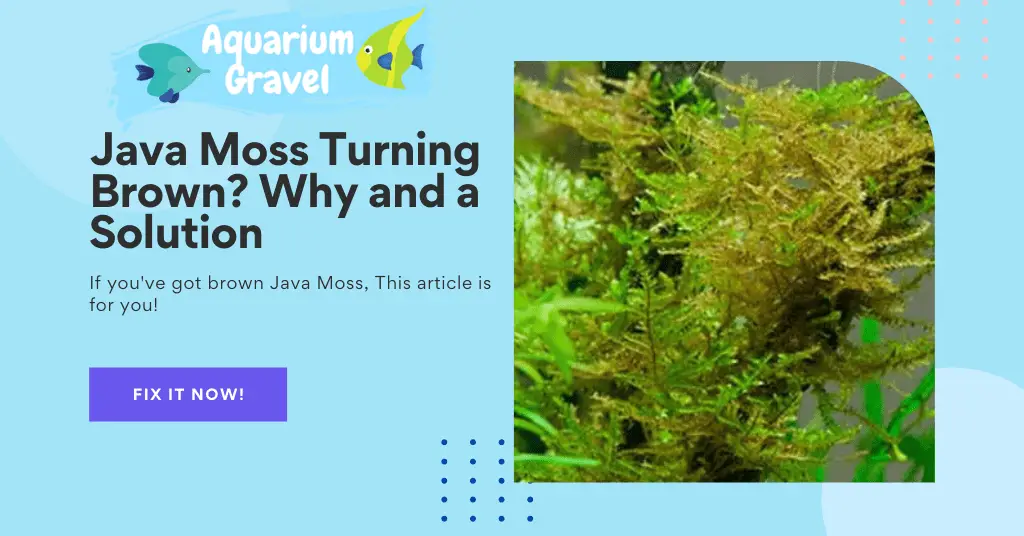Last Updated on October 30, 2021 by cmoarz
Java Moss, not to be confused as Christmas Moss (Xmas Moss) is one of the most popular and easy-to-maintain aquarium mosses across the globe. For good reason.
It grows everywhere. On river banks, tree trunks, most areas in the warmer Southeast Asia especially. New growth always tends to be near water flow with good water current and most water types.
This very hardy plant is really easy to grow and has relatively low maintenance involved, which makes it preferable for a fish aquarium. But that isn’t to say there is none at all.
Java Moss can start to turn brown if not properly cared for. This article will help you if you have brown java moss, why that’s happening and the solutions to reverse and repair the damage.

Browning of Java Moss: Reasons & Remedies
Table of Contents
Because java moss is so hardy and resistant to poor tank conditions and water conditions, it’s rare for java moss to turn brown and the most common reason is lack of nutrient absorption and carbon levels that are too low in the tank.
If these problems are allowed to persist, eventually the brown sections will turn into mush and die off completely.
Why is my aquarium Moss turning brown?
Lack of nutrient absorption: Unlike other plants, Java moss has no true roots. The root structures exist only to help attach themselves to objects. So instead of absorbing nutrients through its none existent roots, it does so through its leaves.
Because of this, it doesn’t need to be attached to anything and can grow as a floating plant or use rhizoids to attach to wood or rocks or decorations, and even sand.
This is one of its main features and what gives it so much strength and hardness. But it’s also one of its greatest weaknesses and can cause problems.
When the foliage in the center of the moss become far too dense and populated, nutrient absorption will become reduced and cause the java moss to begin to turn brown.
This is not a unique problem just java moss faces, But many other mosses have this issue as well because of how moss grows.
This problem can’t be fixed with fertilizer alone as the moss won’t be able to take it up, and the brown moss will continue to spread from the middle sections outwards. Its growth rate may also be hindered.
Low carbon dioxide levels: Everything in this world needs carbon to a certain extent, And aquarium plants such as moss are especially so.
Moss uses carbon dioxide to create carbohydrates which it uses for energy for growth, If it gets too low the plant will begin to starve and turn brown.
Other plants in the aquarium may be sucking up all the micronutrients and carbon dioxide and the moss is unable to get what it needs to continue to thrive. This is especially true if there is excessive algae growth in the tank.
In this case, The browning won’t be just located in the center but spread around the plant in seemingly random locations. It’s very easy to spot this problem.
Too many algae in the tank: Algae is like a vampire when it comes to sucking up nutrients, blocking light, and taking all the dissolved gasses for themselves.
All aquariums have some of this none flowering plant in their tank to a certain extent, it’s not always unbeneficial either. It does help keep water quality up by taking up much of the stuff that creates poor water conditions.
The problem starts when the algae growth goes out of control and starts depriving other plants of nutrients, gasses, and light.
When the algae start taking away everything the java moss needs to be healthy and growing, java moss turning brown isn’t far behind.
Lack of light: Contrary to popular belief, Moss LOVES light, and it needs it to grow optimally. If you’ve got too many other plants that are blocking out the light, Such as a thick carpet of duckweed, or algae, or other floating plants and stem plants that like to stretch out over the surface, this can eventually cause browning in your java moss.
While the moss doesn’t need excessive light, it does need some!
Not pruning your moss enough: “Wait you have to prune moss?!” Yes! Just like any other plant, You do need to prune moss. This is to save it from itself!
When moss growth gets out of control, oftentimes it ends up blocking its own light source, either from above or from the glass sides of the aquarium.
Of course, This will lead to brown java moss!

How do you make Java moss green again?
If your moss turned brown because of a nutrient absorption problem, Consider breaking the plant up a bit to create new centers that aren’t overly dense. Add some fertilizer to the water, But not too much. You want to stop the dense growth from happening again which will happen from too much fertilization. If it happens again it turns brown again!
If your moss is spotty and turning brown because of low carbon levels, the best way to fix it is to just add a bit of liquid carbon. Something like Flourish Excel is an amazing product (just don’t overdo it!)
You can also consider adding more fish if your tank is understocked. Fish will naturally help release carbon and other trace minerals and gases into the aquarium
If your browning problems are caused by excessive algae growth then there are some steps you can take to control that algae growth. Reduce the amount of incoming light. Remove visible algae from the tank manually. Consider adding algae-eating fish, such as snails, shrimp, etc.
If the java moss turns brown because of a lack of light, consider pruning your moss as well as the plants above it that may be blocking light. Upgrade to a more powerful aquarium light if necessary to cover the entire size of the tank.
Be aware that excessive light can cause algae blooms as well, and you will need to find a balance.
So, can brown java moss turn green again? Yes, it can. With proper care, nutrients, lighting, appropriate heat, and water conditions, as well as occasional pruning when necessary, Brown java moss can turn green again!
How do you fertilize Moss?
Because moss doesn’t have any roots, The best kind of fertilizer to use is a liquid fertilizer. To administer these liquid fertilizers, simply add the instructed amounts into the water column right above the moss itself.
Don’t use any fertilizers that need to be buried under the substrate and they won’t do the moss any good.
Java moss does not need to be fertilized very often, if at all unless you’re attempting to reverse a nutrient absorption problem.
The type of fertilizer you use is pretty basic. API Leaf zone is more than enough for java moss. Do keep in mind if you fertilize your moss you will need to increase the light levels on the moss so it can utilize that excess nutrient, and avoid algae growth.

Can dried moss come back to life?
There are two types of dried moss. Moss has been desiccated by having all the water removed from it via sun drying or just low water conditions. This kind of moss is often sold as dehydrated moss for various purposes and is expected to make a full recovery when added to water with adequate lighting. It may take a couple of months for it to fully recover.
The other kind is the moss that has been treated with various chemicals, Heat-treated or irradiated. This kind of moss is often prepared in this way as mulch for plant beds, decorations, arts and crafts, etc. This moss can not come back to life, as the chemical treatment/heat/irradiation has killed it.
So if you just find some moss outside and it’s very dry, it’s probably still alive and just needs to be added to water. If you pick up something from the gardening store that’s meant to be a plant bed mulch, Most likely it’s never going to grow again and is certainly dead.
Some other common Problems with Java Moss
One of the most common problems people have with moss is with temperatures. Java moss can tolerate temperatures up to 86°F (30°C) but does best between 69.8°F (21°C) and 75.2°F (24°C).
In fact, Java moss will almost entirely stop growing at 86°F (30°C). It may even begin to turn brown at higher temperatures.
Java moss also prefers a slight to strong water current with soft acid water. While it’s not mandatory to have this water type, it’s much preferred by the moss and will give the most growth and beautiful green shade. If you want it to turn green even more so then definitely give it the optimal water conditions.

About
Owner of AquariumGravel.com and also owner of actual Aquarium Gravel believe it or not! ;). Setting up beautiful aquarium sceneries and habitats since I was very young. Enjoy!
- Web |
- More Posts(290)

